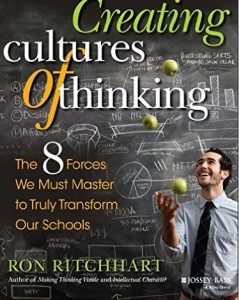
Do your schools and learning communities promote curiosity, innovation, collaboration, empathy, determination, and analytic thinking? Ron Ritchhart, a senior research associate at Harvard Project Zero and a fellow at the University of Melbourne in Australia, argues that although these are the most critical skills to impart upon students, they are not the skills that typical learning cultures foster. In Creating Cultures of Thinking: The 8 Forces We Must Master to Truly Transform Our Schools, Ritchhart asserts that we can build learning spaces that emphasize thinking by focusing on our construction of expectations, language, time, modeled behavior, learning opportunities, routines, interactions, and the learning environment. Ritchhart acknowledges that there are many paths to creating cultures of thinking, but all schools that have successfully shifted towards cultures of thinking had a clear vision, tools to help them achieve that vision, plans to facilitate long-term change, and the wisdom to celebrate growth. Because Ritchhart provides numerous concrete tools for fostering a culture of thinking, this book is a useful guide for any bold teacher or educator ready to transform his class or school into one filled with thinkers.
In a culture of thinking, all participants bring a passion to the task at hand; they share a vision, common goals, mutual respect, and special language. No one—including the leader—dominates, but rather all input is valued. Participants listen actively and taking time for reflection is encouraged.
Ritchhart contends that classes in which expectations are less about student’s obedient behavior and more about goals for knowing, doing, and achieving are closer to promoting a culture of thinking. Teachers should monitor students’ learning and understanding more closely than their work product and recitation of knowledge. With continuous feedback, teachers should work to promote independence in students and a sense that their intelligence can grow. Doing so means teachers need to pay close attention to their choice of words. Language should be inclusive, warm, humble, and questioning. Focused listening is a critical preliminary step in using language effectively to create a culture of thinking.
If teachers value student thinking, they need to make time for their students to wrestle with ideas. Students need time to formulate complex answers and test themselves. Teachers should reflect about the core concepts or skills they want their students to learn, and focus on those. Ritchhart argues that managing one’s time can be very difficult and even futile; instead, he advocates managing one’s energy by engaging in, as much as possible, activities that are satisfying—activities that give more energy than they demand.
When we appreciate that the way we spend our time is a signal of what we value, we may shift our patterns to ensure that we spend time on critical activities such as creating personal connections with students and giving extensive feedback. Indeed, interactions in which educators listen to students, ask thoughtful questions, promote collaboration, and are supportive, respectful, trusting, and encouraging of risks are exactly the kinds of interactions that Ritchhart argues promotes a culture of thinking.
This book provides examples of instructors who demonstrate that when teachers show themselves to be authentically passionate about their topic area, lovers of learning, and reflective individuals, they model for their students the skills necessary to be a thinker. Teachers can allow students to demonstrate these same attributes by creating novel learning opportunities that are easy for students to begin, that can sustain them for the depth of investigation the students wish to pursue, and that give students a chance to produce something valuable.
Having well established routines in which students know what to do, can provide structure to thought and to the learning process. For example, teaching students to make a claim, support it, and question it gives them a pattern they can successful employ across learning situations. Finally, Ritchhart shows that while teachers may feel as though they do not have much control over the physical environment in which they teach, there typically are slight adjustments that a teacher can make to create a more comfortable and collaborative learning space. Ordering desks in a “C” shape can signal that discussion is encouraged; displaying samples of student learning products can enlighten and enliven a class; giving students tools to fidget with in a non-disruptive way reduces behavioral concerns; soft lamp lightening rather than harsh overhead lights creates a calm space to learn.
Ritchhart argues convincingly that shifting towards a culture of thinking is a worthwhile investment in nurturing the type of adults we hope to see in the next generation.
Ritchhart, R. (2015). Creating Cultures of Thinking: The 8 forces we must master to truly transform our schools. John Wiley & Sons.




